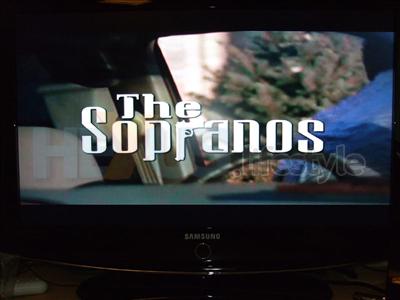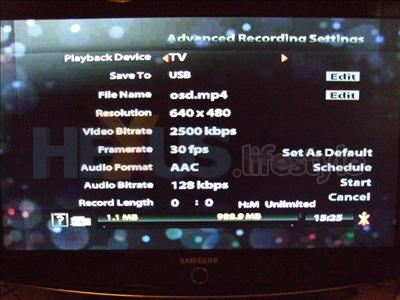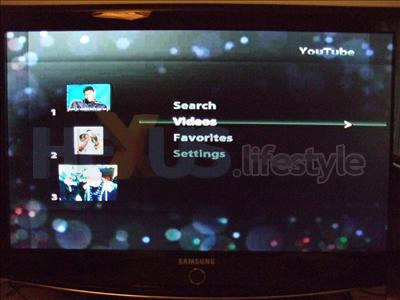Neuros OSD in action
Once up and running, the first thing you'll see is a rather average looking home screen. Pixelated and about as crude as they come, I actually spent a while configuring my TV's options to ensure I hadn't mis-configured my display. That wasn't the case, the OSD's interface just isn't pretty. Functional? Yes. Pretty? No.
The OSD's standard theme and indeed its standard below-average screensaver can be changed with a little tweaking, but I would have preferred to have something a little easier on the eye straight out of the box. It may not have helped that I tried the device on only two displays, a 32" HD screen and a 50" HD screen, both perhaps only further highlighting the OSD's inability to visually impress.
After the initial disappointment however, the OSD does a lot to impress. Though without any internal storage of its own, you can connect just about any external storage option of your choice, be it a memory card, USB stick, external hard drive or networked device. Should the devices contain any media, the OSD will play them back without asking twice. I haven't found a format yet that this device won't playback, I mean, it even played back .ogg files! It's a refreshing change to be able to play anything and everything without any concerns of DRM and missing codecs.
Next up from playing back, is recording. Keeping in line with simplicity, it's about as straight forward as it could be. Connect any source with the provided RCA cables, be it a TV, digital set top box, DVD player or even a games console, and you'll be able to record straight to your OSD's attached storage. A very tidy method of creating a library of all your DVDs.
Recording proves to be useful, but playing back is less so. The OSD records in the standard MP4 format and though a choice of quality settings are available upon recording, the standard 640x480 VGA quality doesn't quite live up to expectations in today's high-definition world. Available resolutions are; 320x240, 352,240, 512x384, 640x480 and 672x448. Video bitrate options scale from 256kbps up to 2500kbps and audio, recordable in MP3 or AAC format, has a maximum bitrate of 128kbps. It isn't bad for general viewing by any means, in a bedroom it'll do the trick and it's perfectly watchable. But without HD support and HDMI connectivity, many users may see the OSD as an older technology and not as future proof as they'd hoped.
As with playback, recordings can be saved to any device you choose to connect, including networked locations. Another handy recording feature is that the OSD comes complete with preset recording settings for devices such as Sony's PSP and Apple's iPod. Selecting any such preset will define all recording resolutions and settings as appropriate for playback on the chosen device.
Playing back anything, recording everything and storing anywhere aren't all that the Neuros OSD will do. Thanks to ongoing community support and software enhancements, the latest OSD firmware now also includes a decent YouTube browser, allowing you to search, view and even queue videos from the popular website. Image slideshows are also available and the list of can-do items on the OSD will only grow.
To keep control of the device is an IR remote control which can be configured to control other devices such as your set top box. The remote isn't the best looking, but in tune with the rest of the OSD, it's as functional as needs be.













